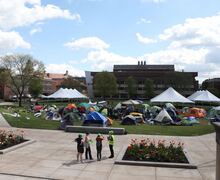Marriage and family therapy department moves location to James Street
To provide a larger, more technologically advanced working environment for students, the department of marriage and family therapy in the College of Human Ecology began the process of moving to an off-campus location Monday.
“It’s a great opportunity for the students to be able to train at a place and have access to knowledgeable health staff right on-site,” said Thom deLara, the chair of marriage and family therapy.
The department, which includes the Goldberg Couple and Family Therapy Clinic, is leasing space from Liberty Resources, a Central New York human services agency, at 1045 James St. The department was previously located at 426 Ostrom Ave.
At the Goldberg clinic, students in marriage and family therapy master’s or doctorate programs provide counseling under the supervision of faculty to families, couples and individuals who are having difficulties including relationship trouble, problems with children, and struggles with depression and anxiety.
The new building will house the clinic, classrooms and department offices. The department agreed on the move two years ago.
As part of the lease agreement, Liberty Resources will provide the department with technology such as a “smart classroom” with video-conferencing and counseling rooms with digital video imaging for clinical training purposes, deLara said. Students already began training with the new equipment, he said.
Liberty Resources could not be reached for comment Monday to elaborate on the partnership with the marriage and family therapy department.
The move saves money for the university, deLara said, but he could not provide specific details about how much was saved. Diane Murphy, the dean of the College of Human Ecology, could not be reached for comment Monday to provide those financial details.
“The arrangement winds up being much better financially for the university and the college than the previous arrangement we had,” deLara said.
Despite the department’s new off-campus location, deLara said there are no worries that students will have trouble accessing it. When the decision was made to move two years ago, the department polled students to determine whether they had personal transportation to travel to the building.
“About 90 percent of the students have their own transportation – actually, higher than 90 percent,” deLara said. “We looked at a number of factors, including how many students lived on that side of town. It seemed like it was a pretty reasonable thing for them.”
Published on April 5, 2010 at 12:00 pm




